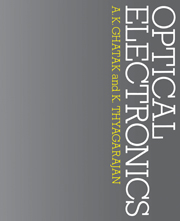Book contents
- Frontmatter
- Contents
- Preface
- 1 Maxwell's equations and propagation of electromagnetic waves
- 2 Reflection and refraction of electromagnetic waves
- 3 Wave propagation in anisotropic media
- 4 Fraunhofer diffraction
- 5 Fresnel diffraction
- 6 Spatial frequency filtering
- 7 Holography
- 8 Lasers: I
- 9 Lasers: II
- 10 Some laser systems
- 11 Electromagnetic analysis of the simplest optical waveguide
- 12 Leaky modes in optical waveguides
- 13 Optical fibre waveguides
- 14 Integrated optics
- 15 The electrooptic effect
- 16 The strain optic tensor
- 17 Acoustooptlc effect: Raman–Nath diffraction
- 18 Acoustooptic effect: Bragg diffraction
- 19 Acoustooptic devices
- 20 Nonlinear optics
- Appendices
- References and suggested reading
- Index
20 - Nonlinear optics
Published online by Cambridge University Press: 05 June 2012
- Frontmatter
- Contents
- Preface
- 1 Maxwell's equations and propagation of electromagnetic waves
- 2 Reflection and refraction of electromagnetic waves
- 3 Wave propagation in anisotropic media
- 4 Fraunhofer diffraction
- 5 Fresnel diffraction
- 6 Spatial frequency filtering
- 7 Holography
- 8 Lasers: I
- 9 Lasers: II
- 10 Some laser systems
- 11 Electromagnetic analysis of the simplest optical waveguide
- 12 Leaky modes in optical waveguides
- 13 Optical fibre waveguides
- 14 Integrated optics
- 15 The electrooptic effect
- 16 The strain optic tensor
- 17 Acoustooptlc effect: Raman–Nath diffraction
- 18 Acoustooptic effect: Bragg diffraction
- 19 Acoustooptic devices
- 20 Nonlinear optics
- Appendices
- References and suggested reading
- Index
Summary
Introduction
In all that has been discussed in earlier chapters we have assumed that when a light beam propagates through a material, the properties of the material are not affected by the light beam itself. However, if the intensity of the light beam is large enough, the properties of the medium (such as refractive index etc.) are affected and the study of the propagation of a light beam becomes quite involved. For one thing the principle of superposition does not remain valid. This is the domain of nonlinear optics where many new effects are observed. Basically, the nonlinear effects are due to the dependence of properties such as the refractive index on the electric and magnetic fields associated with light beam. Before the advent of lasers, the electric fields associated with light beams were so weak that nonlinear effects could not easily be observed. With the advent of laser beams, it is now possible to have electric fields which are strong enough for many interesting non-linear effects to be observed. It is of interest to mention that the fact that intense electric and magnetic fields change the properties of a medium has been known for a very long time. In 1845 Faraday discovered that the plane of polarization of a light beam propagating through glass is rotated if a magnetic field is applied along the direction of propagation of the light beam.
- Type
- Chapter
- Information
- Optical Electronics , pp. 564 - 586Publisher: Cambridge University PressPrint publication year: 1989



